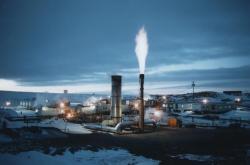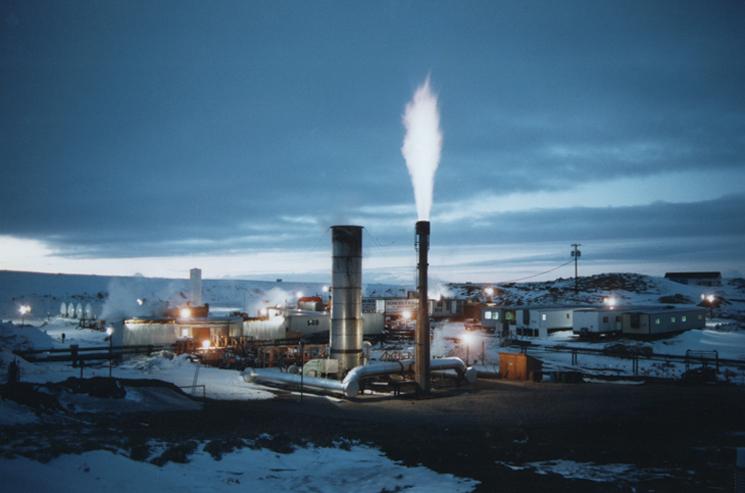
llnlphotosLawrence Livermore National Laboratory demonstrated coal gasification near Hanna, Wyo.
A few years back, Robert Redford narrated a documentary, Fighting Goliath, that told the epic Texas tale of how a coalition of ranchers, environmentalists, and others banded together in the mid-2000s against a giant power company’s plans to build 11 coal plants that would have belched pollution across the state. The film includes scenes of billowing smoke, militant big-city Texas mayors, and protesters carrying signs crying, “No more coal.” One farmer tells an interviewer, “’Til this thing came about, I always looked the other way when I saw an environmentalist.”
When the dust settled, only three plants were approved, and the rest were killed in a buyout of the power company, despite an effort by Gov. Rick Perry (R) to fast-track the scheme.
Today in West Texas, the simple heroism of that tale has been replaced by a far more complex story of trade-offs, pragmatism, and scientific uncertainties about a project slated for what Odessa city officials call “the clean energy capital of the world.” At the heart of it all is one of the very first full-scale tests of that still hazy concept, “clean coal.”
Lying in Penwell, Texas, 15 miles west of Odessa, the $2.5 billion Texas Clean Energy Project would carry out the vision of many scientists and technocrats of turning coal into clean-burning synthetic gas and capturing carbon dioxide that would otherwise be released into the atmosphere, where it would contribute to global warming. The plant, which enjoys nearly three-quarters of a billion dollars in federal aid, would create 1,500 construction jobs over three years, 200 permanent jobs, and make 750,000 tons a year of urea for use on as fertilizer on cropland.
The project’s manager and its most visible spokesperson is former Dallas Mayor Laura Miller, who not coincidentally was the rock star of the anti-power plant effort. Speaking recently to members of the Society of Environmental Journalists, Miller recounted that at the end of that struggle, “I left office, and I was asked, ‘Why don’t you go all around the country to fight coal plants?’ I said, ‘It’s not easy to stop them.’”
“I really want to raise the bar forever,” she said, “so nobody can build a dirty coal plant anymore.”
The devil, however, is in the details.
The plant would transform 2 million tons of coal into synthetic gases each year, then burn the gas to produce electricity. In the process, it promises to capture 90 percent of the greenhouse gases, or 2.5 million tons per year, that the plant produces. The total amount of carbon dioxide emitted into the atmosphere would be less than 10 percent of a conventional coal plant with similar energy output, and less than 25 percent of a high-efficiency natural gas-powered power plant. It will also be capable of capturing 99 percent of sulfur dioxide, 90 percent of nitrogen oxide, and 99 percent of mercury.
Based on that simple accounting, the plant would be a marked improvement over a traditional coal plant. In fact, the U.S. Department of Energy calls this project “the cleanest coal-fueled power plant in the world.” The department has approved $450 million in federal grants for this project, and the Internal Revenue Service has funneled another $313 million to the project in investment tax credits.
But there’s much more to the story. First, the coal would be imported from strip mines in Wyoming’s Powder River Basin — a trip of 1,000 miles via diesel-powered train. Once the CO2 is removed from that coal, it will be piped in a liquid state to oil companies that will use it to boost production in one of the world’s petroleum hotspots: the 100,000-square-mile Permian Basin.
That’s right. This “clean coal” plant will increase the production of another fossil fuel — oil that could easily, when burned, create more CO2 than the coal plant saved in the first place.
The question of whether this project ultimately will produce more greenhouse gases than it saves went unstudied in the federal environmental impact statement that led to the $450 million grant. But an MIT study of a similar project already in operation in southern Saskatchewan doesn’t inspire hope, at least not in the short term. The Weyburn project by 2010 had injected a net 18 million tons of carbon dioxide into the ground to aid in oil extraction. That will enable the recovery of 130 million barrels of oil over 25 years, according to the study — and burning that oil in turn will generate 45 million tons of CO2. That’s a net increase of 27 million tons of CO2 pumped into the atmosphere.
In 2009, scientists at the Carnegie Mellon Institute did a major study of this type of project. (In official parlance, extracting CO2 and pumping it into the ground is called “carbon capture and storage,” and using it to pump oil is called “enhanced oil recovery.”) They found that these projects can have a net carbon benefit, but only if their “clean” power output creates enough of a carbon savings when displacing a dirtier plant to make up for the burning of the oil extracted with the CO2.
Even Susan Hovorka, a research scientist for the Texas Bureau of Economic Geology, which gets one-third of its budget from industries including oil, says the Texas clean energy plant won’t benefit the atmosphere from a carbon standpoint. She called the Carnegie Mellon study “a good study, a legitimate study,” one that should cause concern among environmentalists.
There are two things worth mentioning about this. First, squeezing more oil out of existing fields is preferable to developing new fields in places like Alaska — or so says Laura Miller, who won at least the tacit endorsement for the Texas project from the Natural Resources Defense Council and the Environmental Defense Fund.
NRDC cites an oil and gas industry consulting firm’s study saying that injecting CO2 into “stranded” oil fields — what’s left after the fields are exhausted through conventional techniques — could recover up to 61 billion barrels of oil nationally using current technologies, or more than 10 times the U.S. annual production. New technologies could up that number to 137 billion barrels, according to the study [PDF].
Second, the plant itself will emit substantially less CO2 than a traditional coal-fired plant. But here, too, there’s a hitch. While the plant will sell half of its power to San Antonio (to replace power generated by a traditional coal plant slated to close in 2018), the other half will go to power the clean coal plant itself and the desalination plant that produces its water; to manufacture and distribute urea, sulfuric acid, and other commercial products that the plant will sell; and to pipe the captured CO2 to the oil fields.
Let’s run through this again: We’re burning fuel to haul strip-mined coal cross-country, then using that coal to generate electricity and liquid CO2 that will be used to pump more oil out of the ground to produce … more fuel?
“You’re simply using CO2 to get more CO2,” says Kyle Ash, a D.C.-based legislative lobbyist with Greenpeace.
Greenpeace opposes carbon capture and storage on economic as well as environmental grounds, and denounces enhanced oil recovery as “a scam.” The group cites a long list of cancellations of similar projects in Europe over the past 18 months due to economics and local opposition.
The leader of a local eco-coalition that decided not to fight the Texas project makes it clear that it was an agonizing choice.
Tom “Smitty” Smith, an Austin lobbyist of 25 years for Ralph Nader’s Public Citizen, marched arm in arm with Miller to fight the dirty coal plants. Smith said Public Citizen’s unequivocal view remains that there’s no such thing as clean coal, due to the environmental costs of mining coal and shipping it to even a clean power plant. Ultimately, however, the group decided there was little chance to stop the project in oil-rich Texas and that it was still better than a dirty coal or a natural gas plant.
“It was a decision we struggled over for months,” Smith says. “This is one that wakes you up at night.”
Miller defends the project. “It’s high time we start capturing the CO2 instead of emitting it,” she says. “Because of the international reluctance to do cap-and-trade or put a price on carbon, the only way to do that is if the projects can somehow be affordable. The only way to do that in the near future is enhanced oil recovery — you have to get revenue from CO2, not just bury it.”
And in the oil fields, CO2 will be an improvement over the alternative, she says. If “something soft” like CO2 isn’t used to get at the oil, something “more violent and more water-intensive” such as fracking will be used instead.
Hovorka adds that the plant will push clean coal technology forward, making future plants more affordable and less dependent on oil-drilling schemes to survive. “It’s the first step and hardest step to get the capture going,” Hovorka says. “It gets us halfway — and that’s not something to be disdained.”
All the needed permits are in, and in addition to the $763 million in federal backing, the Texas Clean Energy Project has $1 billion in investments from state-run Chinese companies. Assuming the remaining financing rolls in on time, the Summit Power Group of Dallas hopes to start construction next year and open by 2016 or 2017.



